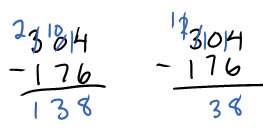Lesson 5: Common student errors
What are error patterns?
Anytime children learn to perform an algorithm without fully understanding it, they will forget how it works, and some children will develop particular errors that they will make consistently. If you see an error that is made only once, then it's probably a careless error--one that comes from not paying attention rather than from a significant misunderstanding. If you see an error that is made several times, it's likely a result of a misunderstanding. Interviews with children about problems are an even better way of learning about the thinking that is producing errors, but we can often figure out thinking that could lead to a pattern of errors by looking at examples of student work.
The error patterns I'll be sharing here are ones that are fairly common for children to make from the standard algorithms for addition and subtraction. Any algorithm that children learn without fully understanding it will lead to error patterns, but the error patterns that you find with the standard algorithms have been studied in some detail, so those are the ones we'll be looking at. If you would like to read further about error patterns in arithmetic, I recommend the book Error Patterns in Computation by Robert B. Ashlock.
Why do children make errors, and how should a teacher react to errors??
Children make errors that show a lack of understanding because they don't know the content thoroughly. Often (usually) people will think that they know things more thoroughly than they do. We tend to believe that we know something when we recognize it--when we look at a problem and its solution and it looks familiar, we think we know that problem and solution. Sometimes we do know what we need to about that problem, but often if we try to solve the problem without any outside help, we find that we didn't know the content as well as we had thought. We (people) tend to confuse familiarity with mastery.
Mastery of content means several things: we know how to solve it, do it, or explain it independently. We have practiced it until we can do it smoothly. We have thought about it so that we understand not just what to do, but why we are performing the steps we are. Mastery means we have seen the concept in several different contexts, and we can recognize it in different places where it appears.
As teachers...
- We should expect that children will need repeated practice and experience with important ideas over time--their knowledge won't become thorough and permanent after only a few weeks or months.
- When children make mistakes that indicate a lack of understanding of why the addition or subtraction process works the way it does, we should make sure that we include a review of why the correct steps make sense as well as a review of what the correct steps are.
- When we revisit important content such as addition and subtraction, we need to think about how to explain why we do what we do, which may mean breaking out manipulatives again, or finding meaningful contexts to clarify the meaning of the problem.
Examples of error patterns: Addition
 |
This example of student work shows an understanding of ones, tens and hundreds, but not of how those are related. In this example, the ones, tens and hundreds have been added separately, but no trading/exchanging has taken place. This work does not show an understanding that when you have 10 or more in a place value, then you have to trade for the next larger place value.
This is one of the most typical student errors. Not trading and regrouping is a common misunderstanding, and it shows a fragility in the students understanding of place value. Notice that in this example you can't tell in what order the student is performing the steps--it would look the same left to right or right to left. |
 |
This example of student work shows that the student has made mistakes in remembering the steps of the standard algorithm. It seems likely that the student doesn't understand the steps that they are misremembering.
This student is working from right to left (you can tell this because the number work in the right columns is affecting the sums to the left). This child is "carrying" the ones place of each sum over rather than the ones place of the sum. I use the word carrying here to indicate that the child isn't thinking through the logic that 10 ones is equal to a ten, but instead is recalling a set of steps whereby one of the digits is moved to the next column. |
Subtraction
 |
This is possibly the most common of the subtraction errors. This child has subtracted the numbers in each column without consideration for whether they are in the minuend (top) or subtrahend (bottom). The different roles of the minuend and subtrahend is somewhat fragile knowledge for some children, and in the context of multi-digit addition, which is more abstract and less familiar, some students will reverse the order of subtraction. |
 |
Another common place where children run into trouble is with subtraction where a middle digit is 0. The double-trade (hundreds for tens, and then tens for ones) is something that students may do incorrectly, even if they can subtract correctly in other situations. There are several different ways to incorrectly "borrow" in order to subtract--the examples to the left are two different mistakes a student might make. In both cases, the mistake is a sign that students have learned a set of steps to subtract without understanding those steps in a way that would let them apply those steps to this typr of problem. |



